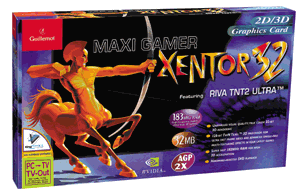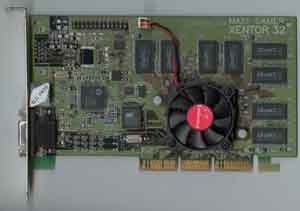
Original Link: https://www.anandtech.com/show/306
Guillemot Maxi Gamer Xentor 32 TNT2 Ultra
by Anand Lal Shimpi on May 30, 1999 9:46 PM EST- Posted in
- GPUs
| Love at first sight was the case with AnandTech and Guillemot's Home Studio Pro 64 professional sound solution, unfortunately since then, Guillemot has had very little of the same caliber to show the market. They did have a bit of success with a few of their gaming peripherals, such as their Race Leader Force Feedback steering wheel, however from the hard core gamer's perspective, Guillemot's Maxi Gamer line of products never cut it. |  |
| While companies like Hercules are striving to compete with the best of the best, Guillemot seems to take more of a relaxed approach to competition in the industry, most likely because Guillemot's product base is much more diversified than the Hercules' of the industry. | |
Guillemot's Voodoo2 and Banshee products did attract some attention last year, as they happened to be priced more attractively than the Diamond and other competing solutions. One notable absence from Guillemot's Maxi Gamer product line was the NVIDIA Riva TNT, or any NVIDIA based solution for that matter. 3dfx seemed to own the entire Maxi Gamer line, and truthfully speaking, that wasn't a problem last year. The Riva TNT, although a competitor to the Voodoo2, wasn't the Voodoo2-killer that everyone was looking for so Guillemot was pretty safe with their faith in 3dfx. However, the company they so adamantly supported ended up ditching them for exclusive sales by their new partner, STB, so what was Guillemot left with? NVIDIA.
3dfx's merger with STB left quite a few manufacturers in the cold, Diamond was an extreme supporter of 3dfx products, and their Monster 3D and Monster 3D-2 solutions were quite popular among the gamers. When 3dfx pulled the plug on companies like Guillemot and Diamond, the only option was to seek out NVIDIA and hope they had something that would sell cards…luckily, they did. Armed with the NVIDIA TNT2 processor, in what is known as its "Ultra" version, Guillemot went all out with their latest addition to the Maxi Gamer line of video products, the Guillemot Maxi Gamer Xentor 32.
Card Specifications
- NVIDIA RIVA TNT2 (Ultra) graphics and multimedia processor clocked at 175MHz
- AGP 2x
- 128-bit TwiN Texel Engine, delivering single cycle multi-texturing
- Up to 32MB of high performance memory clocked at 183MHz
- 32-bit true color 3D rendering
- 32-bit Z/Stencil buffer
- Resolutions up to 1920x1440
- 300 MHz DAC
DVD-VIDEO ACCELERATION
Software Bundle
The Maxi Gamer Xentor and Maxi Gamer Xentor 32 graphics accelerators will be shipping with the OEM version of Interplay's Kingpin(tm): Life of Crime(tm) - On the Street and Ubi Soft's Speed Busters
2D Display Modes |
|||
Resolution |
Colors |
Vertical Refresh Rate |
Monitor Scan Range |
| 1920x1200 | 16.7M 65,536 256 |
60 60-75 60-75 |
90 90-113 90-113 |
1920x1080 |
16.7M 65,536 256 |
60-72 60-85 60-85 |
84-100 84-118 84-118 |
1600x1200 |
16.7M 65,536 256 |
60-75 60-85 60-85 |
75-94 75-106 75-106 |
1280x1024 |
16.7M 65,536 256 |
60-100 60-120 60-120 |
64-109 64-131 64-131 |
1152x864 |
16.7M 65,536 256 |
60-140 60-150 60-150 |
51-126 54-136 54-136 |
1024x768 |
16.7M 65,536 256 |
60-170 60-170 60-170 |
48.3-138 48.3-138 48.3-138 |
800x600 |
16.7M 65,536 256 |
60-240 60-240 60-240 |
37.9-154 37.9-154 37.9-154 |
640x480 |
16.7M 65,536 256 |
60-240 60-240 60-240 |
31.5-126 31.5-126 31.5-126 |
Click here to find lowest prices on this product.
The Card
| The Guillemot Maxi Gamer Xentor 32 isn't an intimidating card at all, unlike the first Voodoo2 cards that hit the streets with their full length PCI stature, the standard sized AGP card is outfitted with a full 32MB of EliteMT manufactured SDRAM. The 5.5ns EliteMT SDRAM is clocked at 183MHz, which is a definite drop from the original 200MHz goal, which was then lowered to 195MHz, and finally bumped down to 183MHz. It seems like Guillemot was trying too hard to compete directly with Hercules' 175/200MHz Dynamite TNT2 Ultra, in doing so they almost released a card that would end up flaking out on quite a few users. | |
| Rather than compete with Hercules, Guillemot decided to rely on different factors to hopefully persuade potential buyers to ditch Hercules and drop their cash on the Xentor 32. The core clock speed of the Xentor 32 is still 175MHz, over 16% faster than what NVIDIA specs the TNT2 Ultra parts at. | |
Although the card is available in a non-Ultra version, Guillemot purposefully made only the Ultra version available in a 32MB flavor. By offering a non-Ultra version in a 32MB flavor Guillemot would have lost some sales of the Xentor 32 cards courtesy of the smarter than the average tweakers that would pursue the non-Ultra card and attempt to overclock it. Unfortunately Guillemot won't allow that, as the 32MB configuration is only available on the Ultra based Xentor 32. Does the extra 16MB of RAM on the Xentor 32 really help? Simply put, when running in 32-bit color, and using the 24-bit Z + 8-bit stencil buffer, yes it does. If you're not going to even touch 32-bit color rendering, then the 16MB version is probably just fine for you.
Like all other TNT2 Ultra based cards, the Xentor 32 makes use of an active cooling device, more specifically, your standard heatsink/fan combo. The unit used on the Xentor 32 is a generic heatsink/fan combo that gets the job done, no more, no less. It's not an expensive unit, and won't let you bump the frequency up to 200MHz+, however it's good enough to keep the chip cool and that's what Guillemot was aiming for. The use of this heatsink/fan unit most likely helped keep the price of the Xentor 32 below the $200 mark that tends to scare potential buyers away. The actual price of the Xentor 32 is $229.99 with a $30 mail-in rebate, bringing the final cost down to $199.99, definitely intended to compete with the Hercules Dynamite TNT2 Ultra priced, interestingly enough, at $229.99 with no mail-in rebate. Don't you just love competition? ;)
The TV-output on the Xentor 32 is driven by the same Brooktree 869 controller that is present on most competing TNT2 boards based on the NVIDIA reference design as well as all Voodoo3 boards that feature TV-out support. The quality is decent, however it isn't as great as the output on the Matrox G400. Other than that, the Xentor 32 is a fairly run-of-the-mill TNT2 Ultra board. In order to keep costs down, Guillemot, like Hercules, opted to remove the digital flat panel output from the board, a wise decision since digital flat panels probably won't become too mainstream until much later this year.
The installation of the Maxi Gamer Xentor 32 went by the book in AnandTech's test systems, Guillemot bundled their own software installation utility with the Xentor 32, unfortunately that did not include a driver installation utility. Upon popping in the driver/utility CD the autorun feature of the CD-ROM allowed AnandTech to install any or all of the bundled game demos and utilities included with the software bundle, including a handy copy of DirectX and DXMedia (it's always good to have a copy on CD just in case). After installing the demos and everything else however, the utility didn't bother to install the Maxi Gamer Xentor 32's bundled drivers. Not a big complaint, but one worth mentioning nevertheless. After proceeding to manually install the drivers, a quick reboot of Windows 98 brought AnandTech one step closer to testing the capabilities of the Xentor 32.
The Maxi Gamer Xentor 32 drivers themselves are nothing more than NVIDIA's reference drivers that bear the Maxi Gamer Xentor 32 name, no fancy tweaks/configuration utilities with these drivers. Closer inspection revealed that Guillemot bundled a very old build of the TNT2 drivers with their card, the exact revision on the CD reviewed was 0130. In AnandTech's first TNT2 review the drivers used were revision 0172 and the drivers AnandTech tested with are revision 0181. It's not uncommon for a TNT2 manufacturer to release their products with an earlier build of the TNT2 drivers as it's better to release a card with tried and true stable drivers rather than release the latest in bleeding edge driver releases from NVIDIA without first testing them thoroughly. Although the performance tests were conducted with the 0181 drivers in order to compare the Maxi Gamer Xentor 32 to the competition, the card's bundled drivers were used as well to make sure no performance anomalies could be attributed to the 0181 drivers.
AnandTech's first experience with the Xentor wasn't too pleasant when it came time to test performance and stability. Fortunately, Guillemot sent us another card that resolved all our problems. Apparently our first Xentor just happened to be one of the occasional bad cards that inevitably happen with any product. This time, everything was completely stable. We went ahead and pushed the limits of this card and were able to obtain 175/200 operation, just like the default of the Hercules Dynamite TNT2 Ultra. Unfortunately, the core was stuck at the default 175. This didn't appear to be due to heat issues as the Xentor actually stayed a few degrees cooler than the Hercules in our recent July 1999 TNT2 Roundup. Thus, it must have been the yield of our particular chip. As always with overclocking, results will vary from card to card.
Guillemot did manage to outfit the Xentor 32 with a nice software bundle, including Xing DVD, a software DVD player, as well as OEM copies of Interplay's Kingpin(tm): Life of Crime(tm) - On the Street (an awesome game) and Ubi Soft's Speed Busters. Keep in mind though, game bundles don't sell cards.
Click here to find lowest prices on this product.
Performance
The performance of the Guiellmot Maxi Gamer Xentor 32 is virtually identical to that of other TNT2 cards out there at the same clock speed. Rather than publishing the same benchmarks over and over again, we encourage you to check out AnandTech's Dynamite TNT2 Ultra Review, our original NVIDIA RIVA TNT2 Review, and the latest July 1999 TNT2 Roundup. Just remember that the Xentor 32 is clocked at a default of 175/183 and our sample was able to hit 175/200 core/memory and remain completely stable.
Final Words
Now that Guillemot has proven that our first sample Xentor was a fluke, the question remains - is the Guillemot Maxi Gamer Xentor 32 worth your money? At $199.99 (after a $30 mail-in rebate), the Xentor 32 is at a unique price point, it is just barely cheaper than the Dynamite TNT2 Ultra yet it is more expensive than the non-Ultra cards. Considering that the card is guaranteed at 175/183 and ours was able to hit 175/200, don't expect to be able to up the memory frequency too far above 183MHz (there's a reason Guillemot dropped the spec from 195 down to 183MHz), and you'll get diminishing returns as the core speed approaches and passes the 183MHz mark, provided it'll even go that far. Overall, the Xentor 32 is a reasonable alternative to the Hercules Dynamite TNT2 Ultra. In fact, if that card wasn't on the market, the Xentor would be the fastest available out of the box. But that's not the case, so you'll have to decide for yourself whether the Hercules and it's higher default speed and higher quality RAM/heatsink/fan are worth an extra $30.








